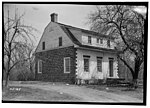Andrew H. Hopper House
Glen Rock, New JerseyHouses in Bergen County, New JerseyHouses on the National Register of Historic Places in New JerseyNational Register of Historic Places in Bergen County, New JerseyNew Jersey Register of Historic Places ... and 1 more
Stone houses in New Jersey
The Andrew H. Hopper House is located at 762 Prospect Street in the borough of Glen Rock in Bergen County, New Jersey, United States. The historic stone house was added to the National Register of Historic Places on January 9, 1983, for its significance in architecture. It was listed as part of the Early Stone Houses of Bergen County Multiple Property Submission (MPS).Based on architectural evidence, the house was built between 1770 and 1805. According to the nomination form, Andrew H. Hopper was building it when his father Hendrick Hopper died in 1805. He later sold it to his son, Henry A. Hopper.
Excerpt from the Wikipedia article Andrew H. Hopper House (License: CC BY-SA 3.0, Authors).Andrew H. Hopper House
Prospect Street,
Geographical coordinates (GPS) Address Nearby Places Show on map
Geographical coordinates (GPS)
| Latitude | Longitude |
|---|---|
| N 40.956527777778 ° | E -74.11 ° |
Address
Prospect Street 752
07452
New Jersey, United States
Open on Google Maps








